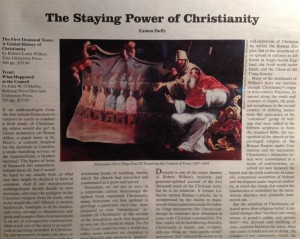 In the same issue of The New York Review of Books that I cited elsewhere (the June 20, 2013 issue), there appears a review essay on two new books on the history of Christianity. Written by the Cambridge University historian, Eamon Duffy, and entitled “The Staying Power of Christianity,” it tackles Robert Wilken’s The First Thousand Years: A Global History of Christianity and John O’ Malley’s Trent: What Happened at the Council. For those interested in bringing more nuanced social theory to the study of religion, Duffy’s opening lines promise much: “If an anthropologist from the star system Sirius were to teleport to earth to conduct a field study of Christianity, where would she go?” What follows is a quick list of several different sites–e.g., a Greek monastery on Mount Athos, a papal mass in St. Peters, a Pentecostal snake-handling service, a Quaker meeting house, etc.–that makes plain that the notion of a homogenous thing called Christianity is hardly a given for many current scholars. “History is written backwards, hindsight is of its essence,” Duffy writes in concluding his introductory paragraph, “and every attempt to characterize any great and complex historical movement is an act of retrospective construction: what is left out of the story is just as significant as anything included.”
In the same issue of The New York Review of Books that I cited elsewhere (the June 20, 2013 issue), there appears a review essay on two new books on the history of Christianity. Written by the Cambridge University historian, Eamon Duffy, and entitled “The Staying Power of Christianity,” it tackles Robert Wilken’s The First Thousand Years: A Global History of Christianity and John O’ Malley’s Trent: What Happened at the Council. For those interested in bringing more nuanced social theory to the study of religion, Duffy’s opening lines promise much: “If an anthropologist from the star system Sirius were to teleport to earth to conduct a field study of Christianity, where would she go?” What follows is a quick list of several different sites–e.g., a Greek monastery on Mount Athos, a papal mass in St. Peters, a Pentecostal snake-handling service, a Quaker meeting house, etc.–that makes plain that the notion of a homogenous thing called Christianity is hardly a given for many current scholars. “History is written backwards, hindsight is of its essence,” Duffy writes in concluding his introductory paragraph, “and every attempt to characterize any great and complex historical movement is an act of retrospective construction: what is left out of the story is just as significant as anything included.”
From having read a variety of scholars now using social theory in the study of religion, I find that they generally think that a little goes a very long way. To put it another way, I find that, nine times out of ten, all one has to do is read a little further, read a little more carefully, and earlier suspicions about the strategically limited way in which social theory is integrated into a study will become very evident. For just as the now common appearance of plurals in scholarship (i.e., Christianities, Judaisms, religions) seems to be theoretically savvy–inasmuch as such writers are finally putting ahistorical essentialism to bed, once and for all–in leaving unaddressed just what it is about all of these Hinduisms that apparently unites then into one supposed family, such scholars reinscribe an essentialist understanding, doing so all the more effectively (since most readers think the plurals signal that the author is a rigorous, and thus authoritative, historian).
Case in point, in the opening quotation, cited above, what is given with one hand–“History is written backwards”–is quickly taken back with the other, inasmuch as the object of this backward glance somehow pre-exists the observer’s gaze–“every attempt to characterize any great and complex historical movement…”. Our social theory thus applies only to how we characterize things (the form we give to them), but the things themselves (their substance) remain the same–they are, after all “great and complex historical movement[s]” Our job, therefore, is to get it right when we write their developmental narratives. But had Duffy pressed further with how he understood the historian’s inevitable use of backward glances, then he likely would have never written about “the Christian movement” as anything but a hindsight concoction based on the observer’s definition of Christianity and apparent desire to portray it as unfolding in history–a definition that lies unarticulated in his opening list, for just how our celestial anthropologist knew that each of the items listed there comprised an e.g. of this thing called Christianity, prior to having paid a visit to earth, I’ll never know. What’s more, just because Duffy immediately pluralizes his highly traditional notion of “the Christian impulse” that drives history, by adding “if it ever had been one impulse,” doesn’t wash off the smell of philosophical idealism that comes with such presumptions of dynamic, internal sentiments manifesting themselves in the social world.
So my rule of thumb is: when you find social theory being used to get at the supposedly “complex” history of religion–as Duffy approvingly argues that we see in the case of Wilkens’s and O’Malley’s books–then just read a little further, because sooner or later the other shoe may drop and then you’ll come to see that something old has been dressed up as something new, and that the scholar of the supposedly diverse and ambiguous social movement is, in fact, actively constituting the limits of what gets to count as the movement in a very specific way. While this may be pretty obvious in the thinly disguised Christian triumphalism (along with a curiously sexualized set of metaphors) that enables Duffy to conclude that, unlike “the more yielding polytheism of the society in which it first found itself,” Christianity’s “staying power” is to be found in the “hardening of Christianity’s doctrinal core,” it’s in the places where a more nuanced historiography seems to win the day that careful readers will be rewarded with oddly old fashioned finds.
